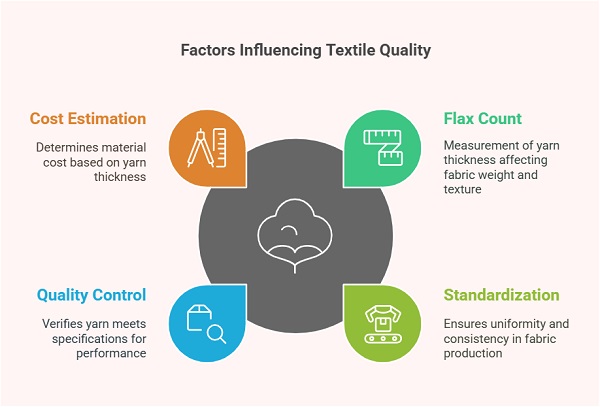Flax Count Calculator
© Yarn Count Ltd. All rights reserved.
Disclaimer: All Tools in the Yarn Count have been reviewed by the relevant spinning industry experts.
The formula for Flax Count
Flax Count = Length (yards) ÷ Weight (lbs)
- Length (yards): Total length of the flax yarn in yards.
- Weight (lbs): Total weight of the flax yarn in pounds.
What is Flax Count?
Flax count is a unit of measurement used to determine the thickness of flax yarn. It helps manufacturers standardize yarn specifications for weaving, knitting, and textile production. The flax count is calculated by measuring the length of yarn in relation to its weight.
In textile manufacturing, count plays a key role in defining the quality, texture, and application of the yarn. A finer count means thinner yarn, suitable for lightweight fabrics, while a lower count represents thicker yarn, ideal for heavy textiles.
Formula for Flax Count
The formula for flax count (NeL) is:
NeL=Length(inyards) ÷ Weight(inpounds)
This means the flax count is determined by how many yards of yarn are needed to make up one pound of weight.
For example:
- If 3000 yards of flax yarn weigh 1 pound, the flax count is 3000 NeL.
- If 1500 yards of flax yarn weigh 1 pound, the flax count is 1500 NeL.
A higher count represents a finer yarn, while a lower count indicates a coarser yarn.
Why is Flax Count Important in Textiles?

Flax count is an essential parameter in the textile industry for the following reasons:
1. Standardization in Fabric Production
Textile mills and manufacturers rely on the count system to ensure consistency in fabric thickness, texture, and quality. It helps in maintaining uniformity across different batches of production.
2. Quality Control
The count measurement helps determine if the yarn meets the required specifications for weaving, knitting, or blending with other fibers. It ensures that the yarn will perform as expected in fabric construction.
3. Cost Estimation
The thickness of the yarn affects the amount of material required for fabric production. A finer count means more yarn is needed to achieve a certain weight, impacting the final cost of the textile product.
How to Use the Flax Count Calculator
Using the flax count calculator is simple and requires just two inputs:
- Measure the length of the yarn – Use a measuring device to determine the length in yards.
- Weigh the yarn – Use a digital scale to measure the weight in pounds.
- Enter the values into the calculator – The tool will instantly compute the flax count.
This helps textile manufacturers, designers, and quality control teams quickly verify yarn specifications.
Factors Affecting Flax Count
Several factors can impact the accuracy of the flax count:

1. Moisture Content
Flax fibers absorb moisture, which can alter the weight of the yarn. Higher moisture levels can lead to incorrect count calculations. To avoid this, yarn should be measured under standard humidity conditions.
2. Spinning Method
The way flax yarn is spun affects its thickness and count. Ring-spun yarns are usually finer, while open-end spinning produces coarser yarns with lower counts.
3. Fiber Quality
High-quality flax fibers produce finer yarns with higher counts. Short-staple fibers, on the other hand, result in thicker yarns with lower counts.
4. Twist Per Inch (TPI)
The number of twists in the yarn affects its strength and thickness. A higher twist increases strength but may slightly alter the perceived count of the yarn.
Conversion of Flax Count to Other Yarn Count Systems
Different textile industries use various count systems. Here’s how flax count (NeL) compares with other common yarn count systems:
| Count System | Formula to Convert from Flax Count (NeL) |
| Cotton Count (Ne) | Ne=NeL×1.43 |
| Metric Count (Nm) | Nm=NeL×1.69 |
| Worsted Count (NeW) | NeW=NeL×0.62 |
For example, if the flax count is 2000 NeL:
- Cotton count = 2000 × 1.43 = 2860 Ne
- Metric count = 2000 × 1.69 = 3380 Nm
- Worsted count = 2000 × 0.62 = 1240 NeW
These conversions help textile professionals compare flax yarn with other yarn types for different applications.
Applications of Flax Yarn
Flax yarn is widely used in textile manufacturing for various purposes, including:
1. Linen Fabric
Flax yarn is the primary raw material for linen fabric, which is used in:
- Apparel such as shirts, dresses, and trousers
- Home textiles like curtains, tablecloths, and bedding
- Upholstery for furniture and automotive interiors
2. Industrial Textiles
Thicker flax yarn is used for:
- Ropes and twines
- Canvas and tarpaulins
- Reinforced composite materials
3. Blended Fabrics
Flax is often blended with cotton, polyester, or wool to enhance the fabric’s durability, softness, and performance. Blended fabrics are used in:
- Workwear and uniforms
- Sportswear
- Sustainable fashion
Advantages of Using Flax Yarn
Flax yarn offers several benefits over other natural fibers:
- Durability – Flax fibers are strong and resistant to wear and tear.
- Breathability – Linen fabrics made from flax yarn allow airflow, making them comfortable in hot climates.
- Moisture Absorption – Flax yarn can absorb moisture without feeling damp, reducing sweat buildup in garments.
- Sustainability – Flax is an eco-friendly fiber that requires less water and fewer pesticides compared to cotton.
Conclusion
The flax count calculator is a valuable tool for textile professionals to determine yarn thickness accurately. By inputting yarn length and weight, users can obtain precise measurements that help maintain fabric quality, standardize production, and optimize costs. Whether used for linen fabrics, industrial textiles, or blended materials, understanding flax count ensures better control over textile manufacturing processes.